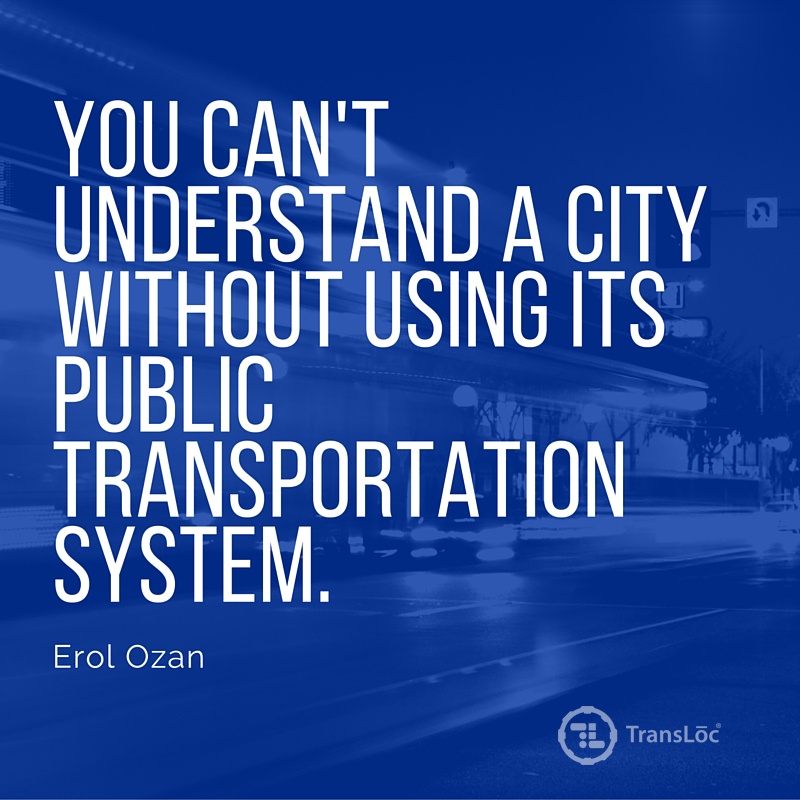
I recently had the pleasure of talking about how people will move in five years at the American Public Transportation Association’s annual meeting. Here at TransLoc, we’re passionate about solving the biggest problems plaguing the public transit industry and as such, I’m taking the liberty of extending this passion beyond the original presentation into a series of four blog posts.
Offering service that wins isn’t about offering service that wins for you as a transit professional. It isn’t about offering service that wins for your agency by minimizing the operational complexity. It isn’t about offering service that wins for politicians with agendas and talking points that exist solely to amass votes.
Offering service that wins is about building a strong, meaningful, sustainable public transit system that remains at the heart of the American mobility environment. It’s about offering service that wins for the riders of public transit—both dependent riders and choice. These people use public transit every day and want it to rise above the current level of service.
Maybe you’re thinking: how do I, as a public transit professional, offer service that wins? That sounds like an expensive, time-consuming, resource-intensive process and you know what I don’t have enough of already? Money, time, and resources. It’s simple:
Understand your riders.
The trouble is, how can we begin to know what wins for riders if we don’t understand them?
To start, it’s important to differentiate between the understanding of a single rider (i.e., “What route does Alex Gibson take to work every day?”) versus understanding a population of riders (i.e., “What is the commuting pattern of individuals who live in the postal code 27604?”). This differentiation is often referred to as micro vs macro. For the purposes of transit planning, macro-level data and analysis is the most valuable, as the goal is to design a transit system for a large population spread over a large area. However, for the purposes of analyzing the efficacy of a single route, micro-level analysis provides deeper insight into how that particular route is performing. In this latter case, the attitudes of individual riders are of immense value, given that the scope of service is limited.
Going deeper, our understanding of riders can be broken down into four main categories:
- Behavior – what does a rider do?
- Desires – what does a rider want?
- Needs – what does a rider require?
- Attitudes – how does a rider feel?
But wait … isn’t that overkill? I’m planning a transit system, not gauging interest in hosting an office holiday party—I don’t care how riders feel.
The truth is, choice riders, by their very definition, can choose how they move. When in doubt, they are going to pick the service that wins for their need. Dependent riders, of course, have limited options, but offering the best service to them is the essence of the American public transit system. In other words, if you’re ignoring how your riders feel, you’re already behind the curve.
How can we begin to understand our riders?
Allow me for a moment, and for the first time in this series, to put on my sales hat and shill for an existing TransLoc product. We recognize that transit planning is difficult. Getting accurate, relevant, and timely data about how, when, and why people use transit is both difficult and expensive. Origin/destination (O/D) surveys involving clipboards and hand-polling people riding buses is time-consuming, often inaccurate, and highly non-scalable. Imagine a world where that type of data is available whenever you need it. Imagine you could combine that data with information about how riders feel about your service:
- In the past 30 days, how would you rate the overall services of the transit system?
- In the past 30 days, how would you rate the transit system for sense of personal security?
- In the past 30 days, how would you rate the transit system for comfort while waiting for the bus?
TransLoc Traveler makes this imaginary world a reality. And it does it right now. In other words, Traveler makes it possible to do both micro- and macro-level analysis of your riders in real time by leveraging the power of one of the major trends affecting public transit: smartphone ownership. Let’s look at a real-world example from one of our customers:
North Carolina State University (NCSU) wanted to cut some existing inefficient service to a shopping center. With the Traveler system, they discovered that they would cut off the access for riders to a grocery store within that complex. Further, they were able to see that the vast majority of these trips were made during the evening. The result? They decided to make the service more efficient during the AM and afternoon hours, but maintained a higher level of service during the evening. In other words, they were able to cut costs while still offering service that wins for their riders.
This type of insight gives immediate, insightful clarity into your existing transit system, and, as the example shows, can impact the decision-making and planning process. Traveler provides a simple, vital solution to better understand the behavior, desires, needs, and attitudes of public transit riders. All of this data, when brought together, gets us closer to answering that most fundamental question: how do I offer service that wins?
Next up? I’ll give you the final piece to this public transit puzzle: how to demand technology that works for you. Five years from now, transit tech will move the world.